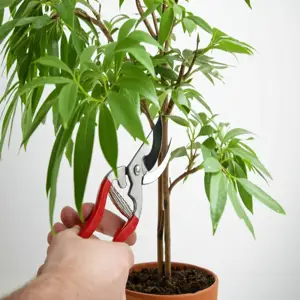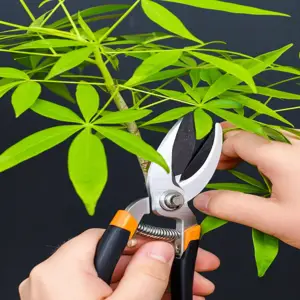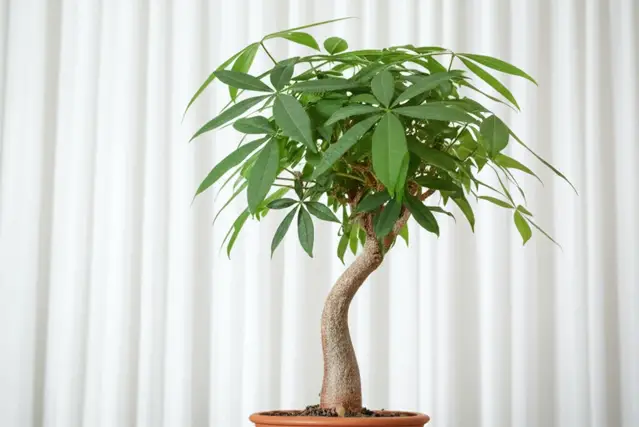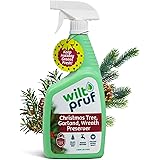The Money Tree (Pachira aquatica) is more than just a houseplant; it’s a symbol of good luck and prosperity. With its braided trunk and vibrant green leaves, it’s a popular choice for homes and offices alike. But to keep your Money Tree thriving and looking its best, knowing how to prune money tree is essential.
This comprehensive guide, updated for 2025, will walk you through the process step-by-step, providing you with the knowledge and confidence to maintain a healthy and beautiful Money Tree.
Why Prune Your Money Tree?
Pruning isn’t just about aesthetics; it’s crucial for the overall health and vitality of your Money Tree. Here’s why you should incorporate pruning into your Money Tree care routine:
- Encourages Bushier Growth: Pruning stimulates new growth, leading to a fuller, more attractive plant. By removing the tips of stems, you encourage the plant to branch out, creating a denser canopy of leaves.
- Maintains Shape and Size: Money Trees can grow quite tall indoors. Pruning allows you to control the height and shape of your plant, keeping it manageable and fitting within your desired space.
- Removes Dead or Damaged Growth: Dead, yellowing, or diseased leaves and branches can detract from the plant’s appearance and potentially spread problems to healthy parts of the tree. Pruning these away keeps the plant healthy and prevents further issues.
- Improves Air Circulation: A dense, overgrown Money Tree can restrict airflow, creating a humid environment that’s conducive to fungal diseases. Pruning helps to improve air circulation, reducing the risk of such problems.
- Redirects Energy: By removing unwanted growth, you redirect the plant’s energy towards healthier and more productive areas. This can lead to stronger growth and more vibrant foliage.
Recent Trends in Money Tree Care: 2025 sees an increased focus on sustainable gardening practices. This includes using rainwater for watering, opting for organic fertilizers, and propagating cuttings to create new plants, reducing the demand on commercial nurseries. The use of self-watering pots and moisture meters is also on the rise, reflecting a trend towards easier and more precise plant care.
Read More: Understanding Pineapple: How Is Pineapple a Fruit
When is the Best Time to Prune?
Timing is key when it comes to pruning. The ideal time to prune your Money Tree is during its active growing season, which typically occurs in:
- Spring: This is the prime time for pruning as the plant is actively growing and can quickly recover from any cuts.
- Early Summer: You can also prune in early summer, giving the plant ample time to produce new growth before the dormant period.
Avoid pruning in the late fall or winter, as the plant’s growth slows down significantly during these months, and it may not be able to heal properly from pruning cuts.

plant trimming
Statistics on Houseplant Popularity: A recent survey by the National Gardening Association found that indoor plant ownership has increased by 20% in the last three years, with Money Trees consistently ranking among the most popular choices. This surge in popularity is driven by factors such as increased awareness of the health benefits of indoor plants and a growing interest in biophilic design.
Tools You’ll Need for Pruning
Having the right tools makes pruning easier and prevents damage to your Money Tree. Here’s what you’ll need:
- Sharp Pruning Shears or Scissors: Use sharp, clean pruning shears or scissors to make clean cuts. Dull blades can crush stems, making them more susceptible to disease.
- Rubbing Alcohol or Disinfectant: Disinfect your pruning tools before and after each use to prevent the spread of diseases.
- Gloves (Optional): Wear gloves to protect your hands from dirt and potential irritants.
- Trash Bag or Container: Have a trash bag or container handy to collect the pruned leaves and branches.
Tool Maintenance Tips: Regularly clean and sharpen your pruning tools to ensure they are always in good working condition. Store them in a dry place to prevent rust.
Step-by-Step Guide to Pruning Your Money Tree
Now, let’s get into the step-by-step process of how to prune money tree:
Step 1: Assess Your Money Tree
Before you start pruning, take a good look at your Money Tree. Identify any:
- Dead or dying leaves and branches
- Yellowing or brown leaves
- Leggy or overgrown stems
- Branches that are crossing or rubbing against each other
- Any signs of disease or pests
This assessment will help you determine which areas need the most attention during pruning.
Step 2: Sanitize Your Pruning Tools
Dip your pruning shears or scissors in rubbing alcohol or a disinfectant solution for at least 30 seconds. This will kill any bacteria or fungi that may be present on the blades.
Step 3: Remove Dead or Damaged Growth
Start by removing any dead, dying, or damaged leaves and branches. Cut these back to the main stem or branch, making sure to leave a small stub (about 1/4 inch) to avoid damaging the healthy tissue.
Step 4: Prune for Shape and Size
Now, it’s time to prune for shape and size. Consider the overall appearance you want to achieve. Here are some common pruning techniques:
- Topping: If your Money Tree is too tall, you can “top” it by cutting off the main stem at your desired height. This will encourage the plant to branch out below the cut, creating a bushier appearance.
- Thinning: Thinning involves removing some of the inner branches to improve air circulation and allow more light to reach the inner leaves. This is especially important for dense Money Trees.
- Heading Back: Heading back involves cutting back the tips of individual stems to encourage branching. Make your cuts just above a leaf node (the point where a leaf emerges from the stem).
Example: Let’s say you have a Money Tree that has grown too tall and leggy. You can top it by cutting off the main stem about 6 inches below the ceiling. Then, you can head back some of the longer stems to encourage branching and create a fuller appearance.
Step 5: Remove Crossing or Rubbing Branches
Branches that cross or rub against each other can create wounds and make the plant more susceptible to disease. Remove one of the branches to eliminate the friction.
Step 6: Make Clean Cuts
When pruning, always make clean, angled cuts. Avoid tearing or crushing the stems, as this can damage the tissue and increase the risk of infection.
Step 7: Dispose of Pruned Material
Collect all the pruned leaves and branches and dispose of them properly. Do not compost diseased material, as this could spread the disease to other plants.
Step 8: Observe Your Money Tree
After pruning, observe your Money Tree closely for any signs of stress or disease. Adjust your care routine as needed to ensure the plant recovers quickly and thrives.
Expert Tip: Don’t be afraid to prune your Money Tree. It’s a resilient plant that can handle pruning quite well. The key is to use sharp, clean tools and make precise cuts.
Read More: Troubleshooting Yellowing Podocarpus: Causes And Solutions
Specific Pruning Scenarios
Here are some specific pruning scenarios and how to address them:
Pruning a Leggy Money Tree
A leggy Money Tree is one that has long, bare stems with few leaves. To prune a leggy Money Tree:
- Top the main stem to encourage branching.
- Head back the longer stems to promote new growth.
- Provide more light, as leggy growth is often a sign of insufficient light.
Pruning a Money Tree with Yellow Leaves
Yellow leaves can indicate a variety of problems, such as overwatering, underwatering, nutrient deficiencies, or pest infestations. Before pruning, address the underlying cause. Then:
- Remove any yellowing leaves, cutting them back to the stem.
- Check the soil moisture and adjust your watering schedule accordingly.
- Fertilize the plant with a balanced fertilizer if necessary.
- Inspect the plant for pests and treat accordingly.
Pruning a Money Tree with Brown Leaves
Brown leaves can be caused by dry air, sunburn, or root rot. Again, address the underlying cause before pruning. Then:
- Remove any brown leaves, cutting them back to the stem.
- Increase humidity by misting the plant or placing it on a pebble tray.
- Protect the plant from direct sunlight.
- Check the roots for signs of rot and repot if necessary.
Money Tree Care Tips for 2025
Pruning is just one aspect of Money Tree care. Here are some additional tips to ensure your plant thrives in 2025:
Light
Money Trees prefer bright, indirect light. Avoid placing them in direct sunlight, as this can scorch the leaves. A spot near an east- or west-facing window is ideal.
Water
Water your Money Tree thoroughly when the top inch of soil is dry to the touch. Allow excess water to drain from the pot to prevent root rot. Reduce watering in the winter when the plant’s growth slows down. Using a moisture meter can really help you dial in your watering routine. They are readily available online and at most garden centers.
Humidity
Money Trees thrive in humid environments. Increase humidity by misting the plant regularly, placing it on a pebble tray filled with water, or using a humidifier.
Temperature
Money Trees prefer temperatures between 65°F and 75°F (18°C and 24°C). Avoid placing them near drafts or heating vents.
Soil
Use a well-draining potting mix for your Money Tree. A mixture of peat moss, perlite, and vermiculite is a good option.
Fertilizer
Fertilize your Money Tree every 2-4 weeks during the growing season (spring and summer) with a balanced liquid fertilizer. Dilute the fertilizer to half strength to avoid burning the roots. Consider an organic fertilizer to align with current sustainability trends.
Repotting
Repot your Money Tree every 1-2 years, or when it becomes root-bound. Choose a pot that is slightly larger than the previous one.
Pest Control
Money Trees are generally resistant to pests, but they can occasionally be infested with spider mites, mealybugs, or aphids. Inspect your plant regularly for signs of pests and treat accordingly with insecticidal soap or neem oil. Consider introducing beneficial insects like ladybugs for a natural pest control method.
Braiding
Many Money Trees are sold with braided trunks. This is done when the plants are young and the stems are still flexible. As the plant grows, the braid will become more permanent. If you want to maintain the braided look, you may need to gently re-braid the stems as they grow, being careful not to damage them. Keep in mind that as the plant matures, the stems will thicken and become less flexible, making braiding more difficult.
Current Trends in Plant Care Products: The market for plant care products is booming, with a growing demand for organic and eco-friendly options. Look for fertilizers, potting mixes, and pest control products that are made from natural ingredients and are safe for both your plants and the environment. Companies are also focusing on creating user-friendly products, such as slow-release fertilizers and pre-mixed potting soils, to make plant care easier for beginners.
Troubleshooting Common Money Tree Problems
Even with the best care, Money Trees can sometimes encounter problems. Here are some common issues and how to troubleshoot them:
- Yellow Leaves: Overwatering, underwatering, nutrient deficiencies, pests
- Brown Leaves: Dry air, sunburn, root rot
- Leaf Drop: Stress, sudden changes in environment, overwatering, underwatering
- Leggy Growth: Insufficient light
- Root Rot: Overwatering, poor drainage
By identifying the problem early and taking corrective action, you can keep your Money Tree healthy and thriving.
The Symbolism of the Money Tree
The Money Tree is more than just a pretty plant; it’s also a symbol of good luck and prosperity. In Feng Shui, it is believed to bring positive energy and financial success to its owner. The five leaves on each stem are said to represent the five elements of Feng Shui: wood, water, earth, fire, and metal. The braided trunk is believed to trap good fortune. Whether you believe in its symbolic powers or not, the Money Tree is a beautiful and easy-to-care-for plant that can bring joy to any home or office.
Propagating Money Tree Cuttings
Want to expand your Money Tree collection? You can easily propagate new plants from cuttings. Here’s how:

money tree care
- Take a Cutting: Cut a 4-6 inch stem from a healthy Money Tree. Remove the lower leaves, leaving only a few at the top.
- Rooting Hormone (Optional): Dip the cut end of the stem in rooting hormone to encourage root growth.
- Plant the Cutting: Plant the cutting in a pot filled with well-draining potting mix.
- Water and Cover: Water the cutting thoroughly and cover it with a plastic bag or humidity dome to create a humid environment.
- Provide Light: Place the cutting in a warm, bright location, but out of direct sunlight.
- Wait for Roots: In a few weeks, the cutting should develop roots. You can check for roots by gently tugging on the stem. If it resists, it has rooted.
- Remove Cover: Once the cutting has rooted, remove the plastic bag or humidity dome gradually over a few days.
- Care for the New Plant: Care for the new Money Tree plant as you would a mature plant.
Sustainability Tip: Propagating your own plants is a sustainable way to expand your plant collection without having to purchase new plants from a nursery. It also allows you to share your love of plants with friends and family.
Money Tree and Feng Shui in 2025
In 2025, the principles of Feng Shui remain relevant for creating harmonious and balanced living spaces. When it comes to Money Trees, their placement and care can further enhance their positive energy.
- Placement: Place your Money Tree in the southeast corner of your home or office, which is the area associated with wealth and prosperity in Feng Shui.
- Avoid Bathrooms: Avoid placing your Money Tree in bathrooms or areas with negative energy, as this can diminish its positive effects.
- Healthy Plant: Keep your Money Tree healthy and well-cared for, as a thriving plant symbolizes growth and abundance.
- Clean Environment: Keep the area around your Money Tree clean and clutter-free to allow positive energy to flow freely.
Regulations Regarding Plant Import/Export: It’s essential to be aware of the regulations regarding the import and export of plants, especially if you are planning to move your Money Tree across state or international borders. Regulations vary depending on the country or state and are designed to prevent the spread of pests and diseases. Contact your local agricultural department or customs agency for specific information on the regulations in your area.
Money Tree Varieties and Hybrids
While *Pachira aquatica* is the most common type of Money Tree, there are other varieties and even some hybrids you might encounter. These variations might have slight differences in leaf shape, size, or even trunk characteristics.
- Dwarf Money Tree: These are smaller cultivars of *Pachira aquatica* that are ideal for smaller spaces or for creating bonsai-like arrangements.
- Variegated Money Tree: These varieties feature leaves with splashes of white or yellow, adding visual interest. Variegation can sometimes require slightly different care, often needing brighter light to maintain the coloring.
- Hybrids: While less common, some nurseries may offer hybrids of *Pachira aquatica* with other closely related species. These hybrids might exhibit unique characteristics, but it’s important to inquire about their specific care requirements.
When purchasing a Money Tree, be sure to ask about the specific variety and its care needs to ensure you are providing the best possible environment for it to thrive.
Read More:
Table: Common Money Tree Problems and Solutions
| Problem | Possible Cause | Solution |
|---|---|---|
| Yellow Leaves | Overwatering, underwatering, nutrient deficiency, pests | Adjust watering schedule, fertilize, inspect for pests |
| Brown Leaves | Dry air, sunburn, root rot | Increase humidity, protect from direct sunlight, check roots for rot |
| Leaf Drop | Stress, sudden change in environment, overwatering, underwatering | Provide consistent care, avoid sudden changes, adjust watering schedule |
| Leggy Growth | Insufficient light | Provide more light |
| Root Rot | Overwatering, poor drainage | Repot in well-draining soil, reduce watering |
| Pests | Infestation of spider mites, mealybugs, aphids | Treat with insecticidal soap or neem oil |
Important Considerations for Pet Owners: While Money Trees are generally considered non-toxic to pets, it’s always best to keep them out of reach. Ingesting large quantities of leaves could cause mild digestive upset. If you have pets that are prone to chewing on plants, consider placing your Money Tree in a hanging basket or on a high shelf.
FAQ: Frequently Asked Questions About Pruning Money Trees
How often should I prune my Money Tree?
You should prune your Money Tree as needed to maintain its shape and health. Typically, pruning once or twice a year during the growing season (spring and summer) is sufficient. However, you can remove dead or damaged leaves and branches at any time.
Can I prune the braided trunk of my Money Tree?
No, you should not prune the braided trunk of your Money Tree. The braid is formed by intertwining the stems of young plants, and pruning the trunk can damage the plant and disrupt its growth. Focus on pruning the branches and leaves to maintain the shape of the tree.
How much of my Money Tree can I prune at once?
As a general rule, you should not remove more than one-third of the plant’s foliage at once. Pruning too much can stress the plant and slow its growth. If you need to do more extensive pruning, do it over a period of several weeks or months.
What do I do if I accidentally over-pruned my Money Tree?
If you accidentally over-pruned your Money Tree, don’t panic. Provide it with optimal care, including bright, indirect light, proper watering, and occasional fertilization. Avoid stressing the plant further by exposing it to extreme temperatures or drafts. With proper care, it should recover and begin to grow again.
Can I use regular scissors to prune my Money Tree?
While you can technically use regular scissors, it’s best to use pruning shears or scissors that are specifically designed for plant care. These tools have sharper blades that make cleaner cuts, which are less likely to damage the plant.
Is it necessary to seal the cut ends after pruning?
Sealing the cut ends after pruning is not usually necessary for Money Trees. The plant’s natural healing process will typically seal the cuts on its own. However, if you are concerned about infection, you can apply a thin layer of pruning sealant to the cut ends.
How do I encourage my Money Tree to branch out after pruning?
To encourage your Money Tree to branch out after pruning, make your cuts just above a leaf node (the point where a leaf emerges from the stem). This will stimulate the growth of new branches from that point.
What if my Money Tree doesn’t grow new leaves after pruning?
If your Money Tree doesn’t grow new leaves after pruning, it could be due to a variety of factors, such as insufficient light, improper watering, or nutrient deficiencies. Make sure you are providing the plant with optimal care and consider fertilizing it with a balanced fertilizer. It may also take some time for the plant to recover from pruning and begin to grow again.
Can I propagate the cuttings from my Money Tree after pruning?
Yes, you can propagate the cuttings from your Money Tree after pruning. Simply follow the steps outlined in the “Propagating Money Tree Cuttings” section above. This is a great way to create new Money Tree plants for yourself or to share with friends and family.
Is pruning my Money Tree necessary for its survival?
While pruning isn’t strictly necessary for the survival of your Money Tree, it is highly recommended for maintaining its health, shape, and appearance. Pruning helps to remove dead or damaged growth, encourage bushier growth, and improve air circulation, all of which contribute to the plant’s overall well-being.
The Future of Houseplant Care: Technological advancements are playing an increasingly important role in houseplant care. Smart devices that monitor soil moisture, light levels, and humidity are becoming more affordable and accessible. These devices can send alerts to your phone when your plants need water or other attention, making it easier to provide optimal care. We can expect to see even more sophisticated tools and technologies emerge in the coming years, further simplifying plant care and helping us to create thriving indoor gardens.
Conclusion: Final Thoughts on How to Prune Money Tree
Mastering how to prune money tree is a vital skill for any plant enthusiast seeking a healthy and vibrant indoor garden. As we’ve explored in this comprehensive guide, pruning isn’t merely about aesthetics; it’s an essential practice that promotes growth, maintains shape, and safeguards against potential health issues. The Money Tree, with its rich symbolism and relatively easy care requirements, remains a popular choice for homes and offices in 2025, and proper pruning plays a crucial role in its longevity and beauty.
Remember, timing is crucial, tools must be sharp and sanitized, and careful assessment is paramount before making any cuts. By following the step-by-step instructions and addressing specific pruning scenarios outlined in this guide, you’ll be well-equipped to nurture your Money Tree and ensure it thrives for years to come. Don’t be afraid to experiment and adapt your approach as you gain experience; each plant is unique and may require slightly different care.
Beyond the practical aspects, cultivating plants like the Money Tree brings numerous benefits to our lives. From purifying the air and reducing stress to fostering a sense of connection with nature, indoor gardening offers a welcome respite from the demands of modern life. As we move further into 2024, let’s embrace the joy of nurturing our green companions and creating thriving indoor oases that enrich our homes and well-being. And, if you are looking to add another great plant to your collection, be sure to check out our guide to caring for ZZ plants.
Auto Amazon Links: No products found.
Perfect Plants Christmas Tree Saver 8oz. | Easy Use Xmas Tree Preserver Food | Have Healthy Green Christmas Trees All Holiday Season
$7.99 (as of December 21, 2025 05:52 GMT +00:00 - More info- Product prices and availability are accurate as of the date/time indicated and are subject to change. Any price and availability information displayed on [relevant Amazon Site(s), as applicable] at the time of purchase will apply to the purchase of this product.
FirEver Pure Christmas Tree Food | Preserver Additive & Season Extender for Live Xmas Trees | Keep It Green, Reduce Needle-Drop | Miracle Freshness (8 oz)
$12.50 (as of December 21, 2025 05:52 GMT +00:00 - More info- Product prices and availability are accurate as of the date/time indicated and are subject to change. Any price and availability information displayed on [relevant Amazon Site(s), as applicable] at the time of purchase will apply to the purchase of this product.
Wilt-Pruf® Christmas Tree/Cutting Preserver Spray |Preserves Christmas Trees, Wreaths, Garlands, Cuttings and Carved Pumpkins | Reduces Needle Drop | Keeps Cut Trees Fresh Longer | Natural (32 oz)
$21.99 (as of December 21, 2025 05:52 GMT +00:00 - More info- Product prices and availability are accurate as of the date/time indicated and are subject to change. Any price and availability information displayed on [relevant Amazon Site(s), as applicable] at the time of purchase will apply to the purchase of this product.
HoHoHoH2o Automatic Christmas Tree Watering System Device, Santa’s Tree Helper Keeps Your Christmas Tree Healthy and Fresh, Refillable 2.5 gallons Capacity Box - Red/Snowflakes
$99.95 (as of December 21, 2025 05:52 GMT +00:00 - More info- Product prices and availability are accurate as of the date/time indicated and are subject to change. Any price and availability information displayed on [relevant Amazon Site(s), as applicable] at the time of purchase will apply to the purchase of this product.
TreeVive™ Natural Christmas Tree Preservative – Extends Freshness & Needle Retention – Enhances Pine Scent – Safe, Non-Toxic, Pet-Friendly Additive for Hydration, Color & Holiday Tree Care
$8.99 (as of December 21, 2025 05:52 GMT +00:00 - More info- Product prices and availability are accurate as of the date/time indicated and are subject to change. Any price and availability information displayed on [relevant Amazon Site(s), as applicable] at the time of purchase will apply to the purchase of this product.
Muddy Mat® | Super Absorbent Door Mat Indoor, Microfiber Quick Dry Chenille Entryway Rug, Non-Slip Front Door Mat, Indoor Mats for Entryway, Machine Washable Pet Rug, Grey 30"x19"
$19.95 (as of December 20, 2025 21:43 GMT +00:00 - More info- Product prices and availability are accurate as of the date/time indicated and are subject to change. Any price and availability information displayed on [relevant Amazon Site(s), as applicable] at the time of purchase will apply to the purchase of this product.
Snow Joe Premium Enviro Blend Ice Melt, Green-Coated Deicer Crystals, 50 lb - Safer Melter for Vegetation, Concrete & Metals w/ Anti-Corrosion Calcium Magnesium Acetate
$32.97 (as of December 20, 2025 21:43 GMT +00:00 - More info- Product prices and availability are accurate as of the date/time indicated and are subject to change. Any price and availability information displayed on [relevant Amazon Site(s), as applicable] at the time of purchase will apply to the purchase of this product.
OLANLY Dog Door Mat for Muddy Paws 30x20, Absorbs Moisture and Dirt, Absorbent Non-Slip Washable Doormat, Quick Dry Chenille Mud Mat for Dogs, Entry Indoor Entryway Carpet for Inside Floor, Grey
$9.49 (as of December 20, 2025 21:43 GMT +00:00 - More info- Product prices and availability are accurate as of the date/time indicated and are subject to change. Any price and availability information displayed on [relevant Amazon Site(s), as applicable] at the time of purchase will apply to the purchase of this product.
Planters' Choice 9 Herb Indoor Window Garden Kit - House Plants Seeds - Best Unique Christmas Gift Ideas for Women, Mom, Friend, Her, Birthday, Housewarming, Mother - New Home Kitchen Gifts
$29.99 (as of December 20, 2025 21:43 GMT +00:00 - More info- Product prices and availability are accurate as of the date/time indicated and are subject to change. Any price and availability information displayed on [relevant Amazon Site(s), as applicable] at the time of purchase will apply to the purchase of this product.
ivtivfu Rolling Grill Basket, Removable Wooden Handle, 304 Stainless Steel, Nesting BBQ Tools, Smoker Grilling Accessories for Vegetable, Outdoor Cooking Camping, Birthday Gifts for Men Dad Husband
$25.99 (as of December 20, 2025 21:43 GMT +00:00 - More info- Product prices and availability are accurate as of the date/time indicated and are subject to change. Any price and availability information displayed on [relevant Amazon Site(s), as applicable] at the time of purchase will apply to the purchase of this product.











